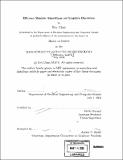| dc.contributor.advisor | Frédo Durand. | en_US |
| dc.contributor.author | Chan, Eric, 1979- | en_US |
| dc.contributor.other | Massachusetts Institute of Technology. Dept. of Electrical Engineering and Computer Science. | en_US |
| dc.date.accessioned | 2006-03-24T18:26:39Z | |
| dc.date.available | 2006-03-24T18:26:39Z | |
| dc.date.copyright | 2004 | en_US |
| dc.date.issued | 2005 | en_US |
| dc.identifier.uri | http://hdl.handle.net/1721.1/30176 | |
| dc.description | Thesis (S.M.)--Massachusetts Institute of Technology, Dept. of Electrical Engineering and Computer Science, February 2005. | en_US |
| dc.description | Includes bibliographical references (p. 85-92). | en_US |
| dc.description.abstract | Shadows are important to computer graphics because they add realism and help the viewer identify spatial relationships. Shadows are also useful story-telling devices. For instance, artists carefully choose the shape, softness, and placement of shadows to establish mood or character. Many shadow generation techniques developed over the years have been used successfully in offline movie production. It is still challenging, however, to compute high-quality shadows in real-time for dynamic scenes. This thesis presents two efficient shadow algorithms. Although these algorithms are designed to run in real-time on graphics hardware, they are also well-suited to offline rendering systems. First, we describe a hybrid algorithm for rendering hard shadows accurately and efficiently. Our method combines the strengths of two existing techniques, shadow maps and shadow volumes. We first use a shadow map to identify the pixels in the image that lie near shadow discontinuities. Then, we perform the shadow-volume computation only at these pixels to ensure accurate shadow edges. This approach simultaneously avoids the edge aliasing artifacts of standard shadow maps and avoids the high fillrate consumption of standard shadow volumes. The algorithm relies on a hardware mechanism that we call a computation mask for rapidly rejecting non-silhouette pixels during rasterization. Second, we present a method for the real-time rendering of soft shadows. Our approach builds on the shadow map algorithm by attaching geometric primitives that we call smoothies to the objects' silhouettes. The smoothies give rise to fake shadows that appear qualitatively like soft shadows, without the cost of densely sampling an area light source. | en_US |
| dc.description.abstract | (cont.) In particular, the softness of the shadow edges depends on the ratio of distances between the light source, the blockers, and the receivers. The soft shadow edges hide objectionable aliasing artifacts that are noticeable with ordinary shadow maps. Our algorithm computes shadows efficiently in image space and maps well to programmable graphics hardware. | en_US |
| dc.description.statementofresponsibility | by Eric Chan. | en_US |
| dc.format.extent | 92 p. | en_US |
| dc.format.extent | 5716220 bytes | |
| dc.format.extent | 5726683 bytes | |
| dc.format.mimetype | application/pdf | |
| dc.format.mimetype | application/pdf | |
| dc.language.iso | eng | en_US |
| dc.publisher | Massachusetts Institute of Technology | en_US |
| dc.rights | M.I.T. theses are protected by copyright. They may be viewed from this source for any purpose, but reproduction or distribution in any format is prohibited without written permission. See provided URL for inquiries about permission. | en_US |
| dc.rights.uri | http://dspace.mit.edu/handle/1721.1/7582 | |
| dc.subject | Electrical Engineering and Computer Science. | en_US |
| dc.title | Efficient shadow algorithms on graphics hardware | en_US |
| dc.type | Thesis | en_US |
| dc.description.degree | S.M. | en_US |
| dc.contributor.department | Massachusetts Institute of Technology. Department of Electrical Engineering and Computer Science | |
| dc.identifier.oclc | 60678787 | en_US |
